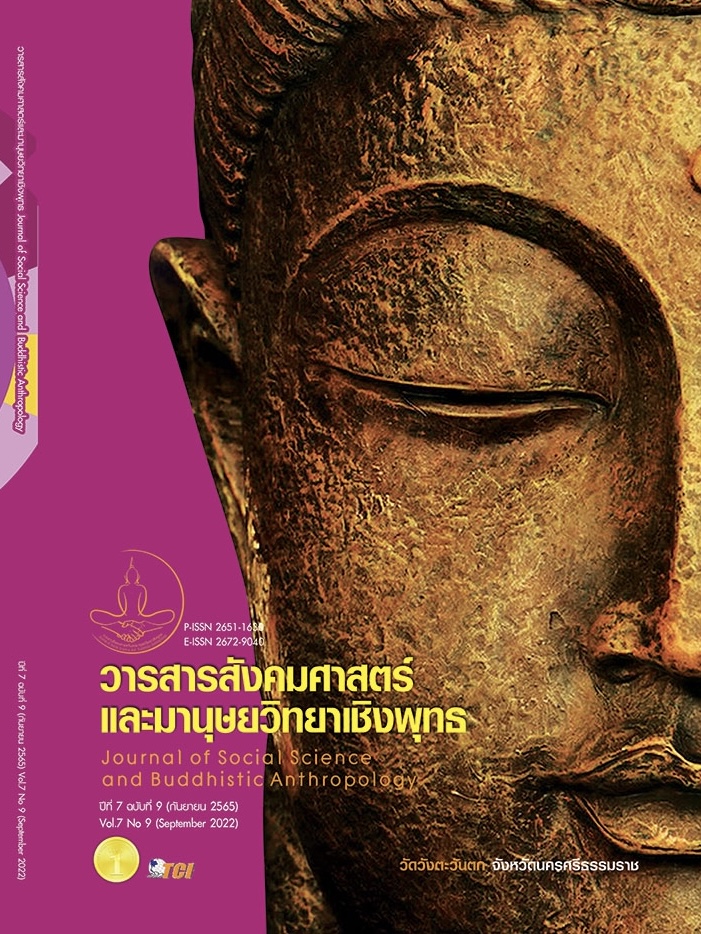STUDENT CARE SYSTEM OF BAN KHLONG KHUT SCHOOL UNDER THE SATUN PRIMARY EDUCATIONAL SERVICE AREA OFFICE
Keywords:
Project Evaluation, Student Care System, CIPP model, Primary schoolAbstract
The objectives of this research article were to evaluate the context, input, process, and products of student care system of Ban khlong khut School by quantitative research. Data was collected from 780 participants in 2563BE by questionnaires, all of whom were purposively selected. Research data was analyzed by using the descriptive statistics: mean and standard deviation. The results showed that: 1) The results of the context evaluation in overall were at the highest level ( = 4.98, S.D. = 0.18), 2) The results of the input evaluation – personal, budgets, media and resources learning and administrative, in overall, were at the highest level (
= 4.87, S.D. = 0.23). 3) The results of the process evaluation were at the highest level (
= 4.88, S.D.= 0.22). 4) The results of the product evaluation are as follows: 1) The school had been assessed and selected for the best schools for getting the student care system award. 2) Students classification results showed there were 501 normal students’ group, 94 risk students’ group and 1 problem student group. 3) Student’s safety activities results showed that there had 10 accidents in school. 4) Health promotion activities results showed there had 10 students who had malnutrition problems and there are encouraged to be ware and have health care behaviors correctly. 5) 109 Students received scholarships. 6) All students continued their studies and no dropout students. 7) Students have desirable attributes at 79.99 % of very good level and 16.48 of good level. 8) Students have life skills at 91.85 of very good and 8.16 of good level. And 9) the stakeholder’s satisfaction toward the project in the overall was at the highest level (
= 4.76, S.D. = 0.10)
References
กรมสามัญศึกษา. (2544). ระบบการดูแลช่วยเหลือนักเรียนในโรงเรียนสังกัดกรมสามัญศึกษา. กรุงเทพมหานคร: การศาสนา.
เชิงยุทธ มุลเอก. (2560). ผลการดำเนินงานระบบดูแลช่วยเหลือนักเรียนโรงเรียนห้องสอนศึกษา อำเภอเมือง จังหวัดแม่ฮ่องสอน. วารสารบัณฑิตวิจัย, 6(1), 37-48.
โชคดี อิ้ววังโส. (2559). การประเมินโครงการระบบดูแลช่วยเหลือนักเรียน โรงเรียนมัธยมเทศบาลวัดท่าแพ เทศบาลเมืองทุ่งสง จังหวัดนครศรีธรรมราช. นครศรีธรรมราช: โรงเรียนมัธยมเทศบาลวัดท่าแพ.
พัฒนา พรหมณี และคนอื่น. (2563). แนวคิดเกี่ยวกับความพึงพอใจและการสร้างแบบสอบถามความพึงพอใจในงาน. วารสารวิชาการสมาคมสถาบันอุดมศึกษาเอกชนแห่งประเทศไทย (สสอท.), 26(1), 59-66.
มนตรา ฟักมงคล. (2563). การประเมินผลโครงการระบบดูแลช่วยเหลือนักเรียนโรงเรียนราชานุบาล สำนักงานเขตพื้นที่การศึกษาประถมศึกษาน่าน เขต 1. วารสารสังคมศาสตร์และมานุษยวิทยาเชิงพุทธ, 6(4), 81-95.
โรงเรียนบ้านคลองขุด. (2562). รายงานประจำปีของสถานศึกษา ปีการศึกษา 2562. สตูล: โรงเรียนบ้านคลองขุด.
วชิระ อาจเอื้อม. (2559). การประเมินโครงการพัฒนาระบบการดูแลช่วยเหลือนักเรียน ปีการศึกษา 2559 โรงเรียนสกลวิสุทธิ. สมุทรสงคราม : โรงเรียนสกลวิสุทธิ.
สมคิด พรมจุ้ย. (2563). เทคนิคการประเมินโครงการ. (พิมพ์ครั้งที่ 7). นนทบุรี : จตุพร ดีไซน์.
สฤษดิ์ วิวาสุขุ. (2563). การประเมินโครงการระบบการดูแลช่วยเหลือนักเรียน โรงเรียนจอมพระประชาสรรค์ สำนักงานเขตพื้นที่การศึกษามัธยมศึกษา เขต 33. วารสารสังคมศาสตร์และมานุษยวิทยาเชิงพุทธ, 8(8), 296-310.
สำนักงานคณะกรรมการการศึกษาขั้นพื้นฐาน. (2547). แนวทางการดำเนินงานระบบดูแลช่วยเหลือนักเรียนในสถานศึกษา. กรุงเทพมหานคร: สำนักงานคณะกรรมการการศึกษาขั้นพื้นฐาน.
สำนักงานคณะกรรมการการศึกษาขั้นพื้นฐาน. (2559). การพัฒนาระบบการดูแลช่วยเหลือนักเรียน. กรุงเทพมหานคร: โรงพิมพ์ชุมนุมสหกรณ์การเกษตรแห่งประเทศไทย.
สำราญ มีแจ้ง. (2558). การประเมินโครงการทางการศึกษา: ทฤษฎีและปฏิบัติ. กรุงเทพมหานคร: โรงพิมพ์แห่งจุฬาลงกรณ์มหาวิทยาลัย.
Nkechi, E.E. (2016). The Role of Guidance and Counselling in Effective Teaching and Learning in Schools. RAY: International Journal of Multidisciplinary Studies, 1(2), 36-48.
Sibley, E. et al. (2017). The Impact of Comprehensive Student Support on Teachers: Knowledge of the Whole Child, Classroom Practice, and Teacher Support. Teaching and Teacher Education, 65(1), 145-156.
Downloads
Published
How to Cite
Issue
Section
License

This work is licensed under a Creative Commons Attribution-NonCommercial-NoDerivatives 4.0 International License.








